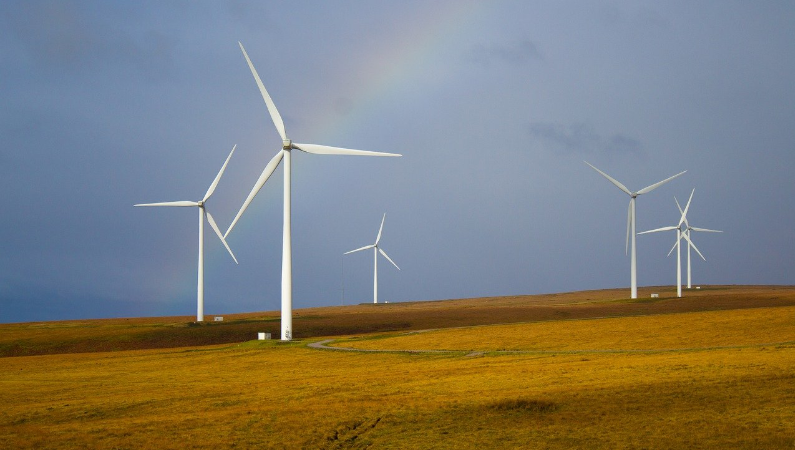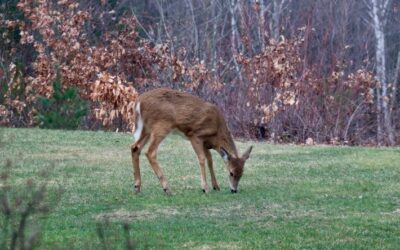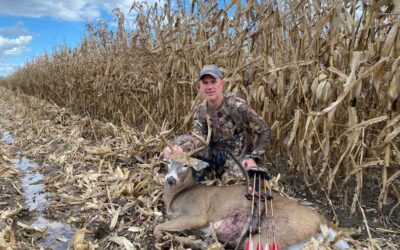All hunters know that wind direction affects how to pick your hunting spots. What hunters do not know is how wind affects deer movement. Most hunters think that wind causes deer to move less during the day.
However, studies were done by Leah Giralico, an undergraduate in the College of Agricultural Science at Penn State University, provide a fascinating statistical report on how wind affects deer movement. I want to challenge your beliefs then get into the why of wind effects on deer movement and how to hunt windy days to maximize your success rate.
Table of Contents
Leah Giralico Studies
Jessica Hepner Studies
Where Deer are Traveling during Windy Days
How Wind Creates More Feeding Deer
How Deer Use the Wind to Scent Check
Bedding Areas Based on Wind
Hunting Strategies for Windy Days
Hunting Strategies after Windy Days
Conclusion
Leah Giralico – Wind’s Surprising Effects on Deer Movement (Published in 2015)
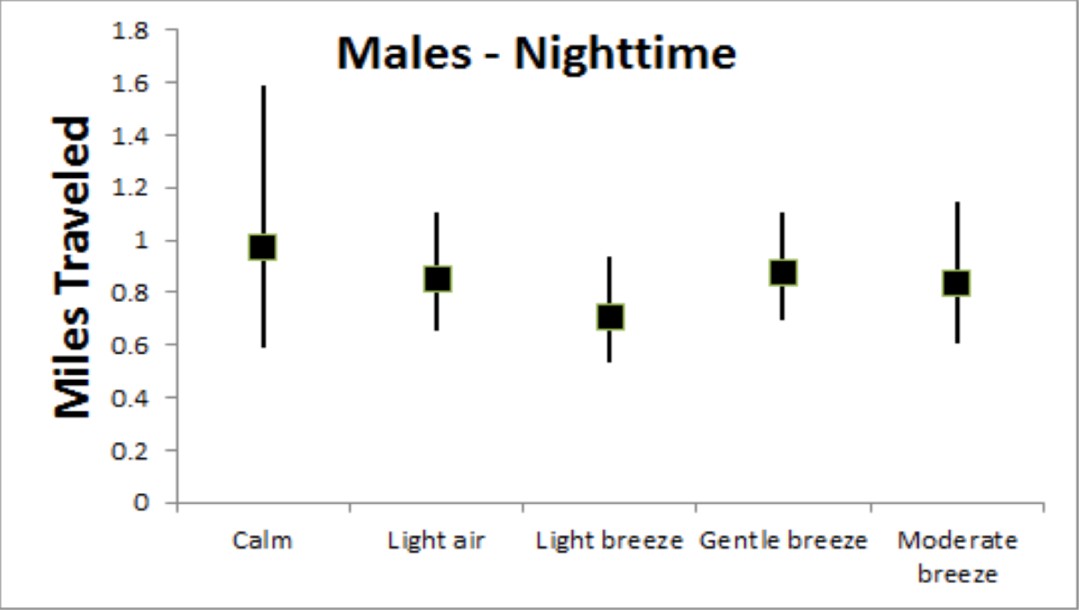
Let’s start by setting some parameters that should be noted in this study. These parameters are variables that no one could change or affect. This is important because uncontrollable variables are what wild deer are living in and what 99% of people hunt.
To start, Giralico analyzed data taken in October of 2013. The weather condition data was provided by NOAA. This is how she backtracked the data of deer movement based on wind speeds. They analyzed over 1700 deer for both day and night.
The month of October in 2013 was not a windy month. The max speeds were only 12mph. This means that data was not recorded about high speeds over 15 mph. (don’t worry we will revise some of this data updated by Jessica Hepner)
Results of Data Collected on Winds Affect on Deer Movement?
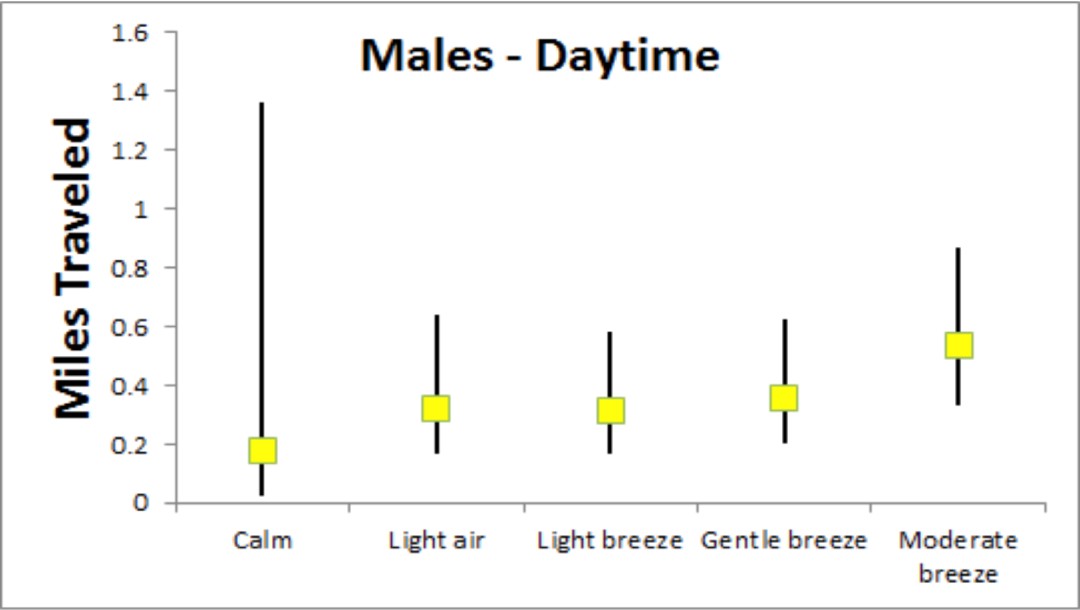
Both these graphs are creditted to Leah Giralico and Penn State University. Data published in 2015.
After Giralico took in all the data, she split the groups into male and female deer. The division of these groups makes a huge difference. I want to focus on buck’s movement based on wind speeds.
The result was found that whitetail bucks increase their daytime movement as the wind speeds increase. However, bucks move less on average during a windy night. Use the graphs that are provided. The boxes represent average day or nighttime movement.
According to this data, the best wind strength for a mature buck to be on the move is during a moderate breeze which according to the study is winds of 10mph or more.
Now that you are informed about how deer move in the wind. I want to look at some updated data that also include how deer move in the wind and rain combined.
Jessica Hepner – Blown Away (Published in 2018)
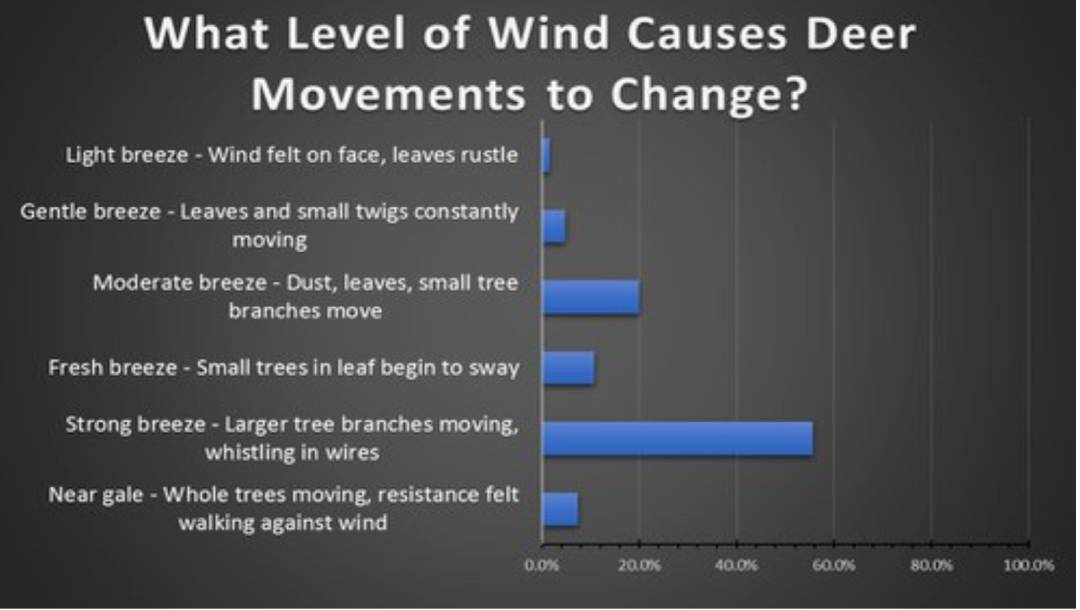
Jessica Hepner’s study was performed when she was an undergraduate studying wildlife and fisheries science at Penn State University. She wanted to update Giralico’s studies to get a more detailed version and hopefully see the effects of deer movement in higher speeds of wind.
This study also showed the effect on buck’s movement in wind and rain. The results are extremely interesting and will test your prior beliefs about how bucks move during windy and rainy conditions.
The results of Jessica Hepner Studies on How WInd Effects Deer Movement (2018)
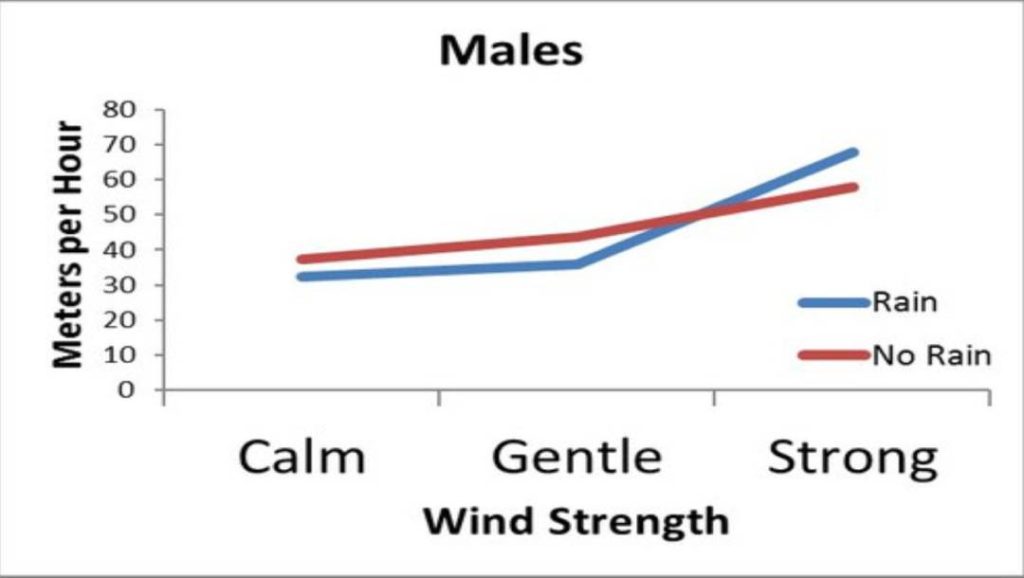
Both Graphs are creditted to the studies conducted by Jessica Hepner and Penn State University. Published in 2018.
The data found in this study showed that almost all Giralico’s studies held true even in 2015. She was able to calculate higher wind speeds in the month of October 2015. The results showed that a continuation of increasing wind speed correlated to an increase in daytime buck movement.
However, the major difference was that the rain does influence bucks’ movement during the day. The chart above shows the relationship between wind strength and rain. Rain alone can cause a decrease in bucks activity levels during the day; nevertheless, strong wind with a slight rain seems to have no effect on bucks’ movement.
The wind is the most important factor in bucks’ movement habits. Basically, science is telling you to still get into the woods even on windy days. How to hunt these windy days is what we need to know now.
Where Deer are Traveling during Windy Days
Now that you have a better understanding of how wind drives deer movement, you need to know how they are moving to capitalize on the best opportunities to catch a buck moving during daylight. The best way to understand this is by generating knowledge of the whitetail deer anatomy and how they use their body parts to ensure safety from predators. Whitetail deer are also sexually driven animals and so if you are hunting the rutting time in your state, it may change your hunting spot.
Where Deer are Moving Based on Wind Effects
In more extreme winds, bucks tend to move to a location that provides some sort of protection from the wind. This could be the downwind side of a ridge, a thicket, or a swamp. Cornfields are also a great area for bucks to get out of the wind because it provides protection from the wind and safety from most predators, especially hunters.
For moderate winds that have less effect on deer movement, bucks may be using the wind to their advantage by checking on bucks rubs and the surrounding area for female deer in estrus. (I will take more about this later).
A Calm Wind or No Wind
Bucks’ travel habits during calm days seemed to show less movement during the day according to both studies done by Giralico and Hepner. You should plan your hunts based on normal factors like travel corridors, frequent bedding areas, and where food sources are located.
How Wind Creates More Feeding Deer
Windy days showed an increase in deer herd movement throughout the daytime but showed a decrease in deer movement during the nighttime. What does this mean?
The effect of wind on deer movement and habits goes beyond when the wind stops. Wind causes the deer to reduce movement during the nighttime. Meaning that they are not spending as much time feeding at night. This opens a special opportunity for hunters to exploit while hunting post windy days.
The deer herd needs to replenish food sources that they did not receive due to the reduced movement at night. Because nighttime is when most deer feed, windy days cause an increase in feeding deer later into the morning… meaning big bucks may make a mistake. This is especially noticeable during rutting season as bucks need to eat and drink often to stay in peak shape to fight bucks, chase does, and breed does.
Extreme wind can also cause acorns, corn, or any other type of food source to become more accessible to deer. The easy and fresh food can lead to an increase in deer feeding after a windy day or night. Acorns are the biggest target food source for hunters after a windy day because they have just fallen and are extremely fresh.
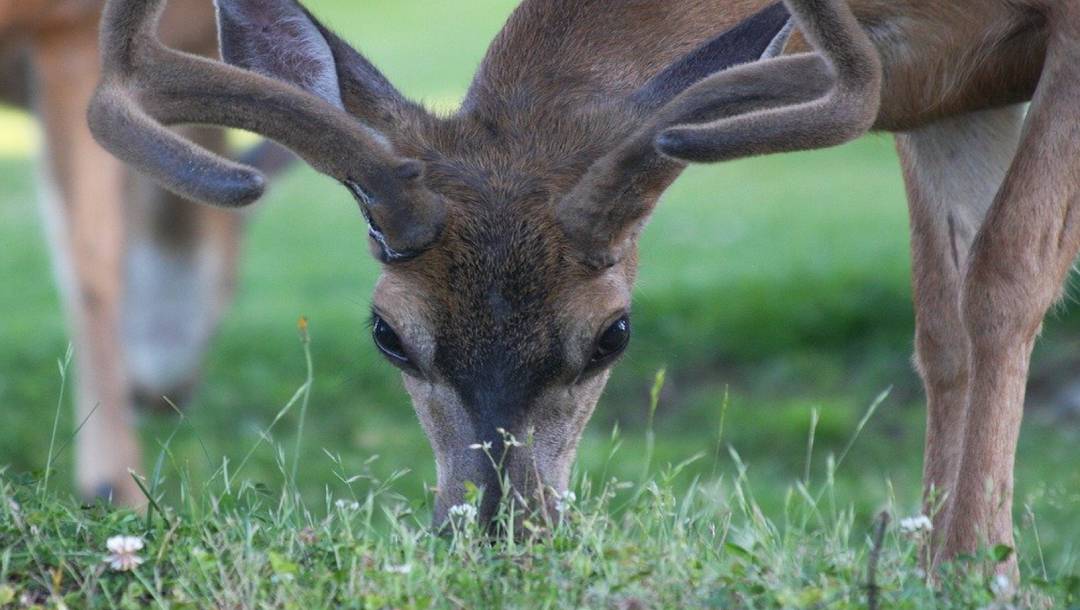
How Deer Use the Wind to Scent Check for Females in Estrus
Whitetail bucks use wind strength and wind direction to search their area and other areas for female deer that are ready to breed. The wind affects buck movement that is searching for does in estrous especially when the winds are low to moderate. With the wind at lower speeds, bucks are less concerned with getting out of the windy conditions.
The mature bucks that have been around for over 3 years know how to use their nose as an advantage. They will cruise the downwind side of their area to scent check. The reason they do this is that does have a certain smell when they are ready to be bread. A buck can cover a lot more ground while searching for a doe if he uses the wind and his nose.
The wind will blow the scent of the doe in the same direction as the wind. The bucks take advantage. If the wind is blowing at high speeds during the rut, bucks will still be out searching for does most of the time. However, the high speeds can cause the wind to spin in circles and not give good scent-checking conditions. Instead, bucks will use their nose but more importantly their eyes.
Note: This idea is most prominent in the pre-rut when bucks are starting to chase and look for does but the does are not quite ready to breed yet. They all want the first one!
Bedding Areas Based on Wind
Wind affects deer movement in more ways than just how deer are moving during the night. Wind affects deer movement in how they bed and where they bed.
How Wind Affects Deer Bedding
Deer will choose to bed down with their noses facing the same direction the wind is blowing. This allows deer to smell any predators behind them and see any predators in front of them. This helps to keep them as safe as possible even when the conditions are not to their advantage.
Where Deer Bed Based on Wind Direction and Wind Speeds.
Deer want to ensure their safety; nevertheless, deer are still under the effects of weather conditions and wind chill. This means that if it is cold and windy, deer want to find places to bed that are both to their advantage with the wind and will protect them from the wind.
Thickets, the opposite side of a ridge, and even in big timber are great places where deer can achieve both incentives. They will be able to smell and see predators without exposing themselves to the extreme cold and wind.
As you can see wind affects deer movement in a variety of ways, and it is important to understand their natural instincts to place yourself in the best hunting spots to capitalize on the extra movement of a windy day.
Hunting Strategies for Windy Days
Now that you have a better and fuller understanding of how wind affects deer movement and how deer travel differently based on wind strength, it is time to talk about how to capitalize on these windy conditions. I want to say that all the data tracked from 2013 by Girlaco’s and 2015 Hepner’s studies that windy and rainy conditions should not deter you from hunting. Rather they should motivate and excite you to get in the woods.
Knowing how deer move and where they move is the most essential part of positioning yourself in a place that will increase your chances of success. I would suggest that you do not always want to go into a 20-foot-high tree stand if the winds are blowing at 20 plus mph. Rather, find some good cover on the ground in a location that will keep you safer in all these windy hunting situations.
Early Season Windy Days
During the early season, windy days are a great way for a bowhunter to exploit the natural life of a whitetail deer. The reason the early season is so great is that hunting pressure has not yet increased to its peak.
So, what is the plan? You may want to find a location that is near a bedding area. But not just any bedding area. You will want to find a bedding area where big bucks are located. This would be a place that is downwind of an open area, a thicket, or a place where deer feel the safest and protected from the elements of wind and rain. Make sure to be sneaky and quiet while entering bedding areas of any kind. You do not want to spook a deer that is already bedded down.
Rut Hunting Windy Days
As many hunters know, the rut can be some of the wildest times to be in the woods. You never know what you will see or what buck may show himself. You want to be out during the pre-rut and rut season as much as you possibly can. Therefore, every year I take a ‘rutcation’ (hunting vacation during the rut).
The main way of hunting on windy days during the rut is to simply be in the tree. With wind affecting deer movement in a positive way combined with the rut increasing bucks’ movement, your chances of laying eyes on a monster buck making a mistake are much higher. So, hunt in windy and non-windy conditions during the rut.
Pre-rut hunting is a little bit different because Bucks are not yet locked down with does. You will want to hunt near scrapes and rubs. This will allow you to take advantage of bucks that are trying to cruise the woods on a windy day that are checking for females in estrus. These weather conditions during the pre-rut are exactly what gave me a shot at a nice 8-point one year. I sadly missed… that is hunting though.
Late Season Hunting Strategies for Windy Conditions
During the late season of whitetail deer hunting, bucks are few and far between. However, this does not mean that it is impossible to tag a big buck after the rut is over.
During a windy day in the winter, you will want to implement one of two strategies based on the time of day you are hunting. If you are hunting in the morning, you may want to find a hunting spot that allows you to be on the path to a bedding area that is out of the cold wind and where deer can bed with the wind at their back.
This will allow you to catch bucks that have been feeding at night as they come back to bed down for the day. The choice of which bedding area is crucial because bucks also want to get themselves out of the wind and cold weather.
Hunting Strategies for after Windy Days
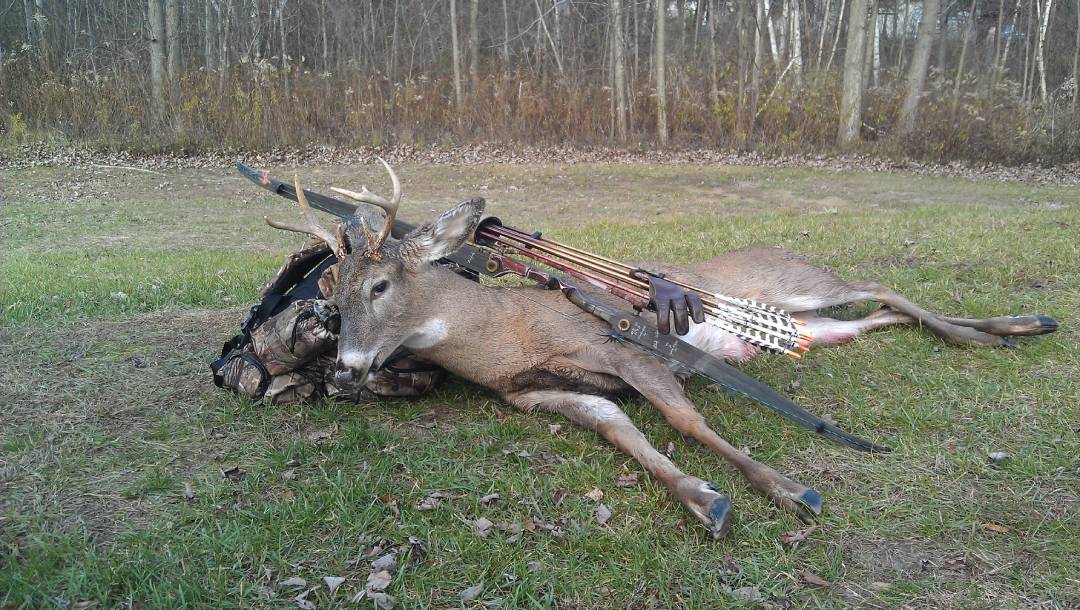
This buck was taken by my father well before I got into hunting. However, I remember him telling me the story. He specifically mentioned how windy the night before had been. So windy that he did not know if he was going to hunt in the morning. He was glad he went out at capitalized on the opportunity!
The wind affects deer movement even after the wind is done howling. If it has been windy all night, the studies show that deer move less at night during windy days. This means that the usual time whitetail deer spend feeding and regaining their nutrients, they are staying bedded down or just in general moving less.
You can use this knowledge to your advantage by hunting near trails that deer travel to food sources. The whitetail deer need to regain their energy at some point. The deer were not feeding because of the wind conditions; they will be spending the next non-windy morning or night feeding to regain energy and nutrients.
This is a powerful tactic that will help you see a lot of deer and give yourself a good chance at shooting a dandy buck or filling a freezer queen.
Conclusion
Wind affects deer movement on many levels. It causes them to move more in the daytime and less in the nighttime. Bucks also increase the average area they travel as the wind speeds increase. Rain increases bucks’ movement throughout the day as well.
The overall takeaway from knowing how wind affects deer movement is that you should never have an excuse or reason to not hunt under such conditions. The science says these are some of the best days to see a buck make a mistake and capitalize.
Work Cited
“Wind’s Surprising Effects on Deer Movement.” Penn State Deer-Forest Study, 20 Apr. 2015, https://www.deer.psu.edu/winds-surprising-effects-on-deer-movement/.
“Blown Away.” Penn State Deer-Forest Study, 26 Mar. 2018, https://www.deer.psu.edu/blown-away/.
Thank you for visiting The Whitetail Teacher! If you enjoyed this post, make sure to share it with a friend.
If you have any questions or recommendations for new blog posts, please use the contact form.
Learn, Plan, Execute,
The Whitetail Teacher

